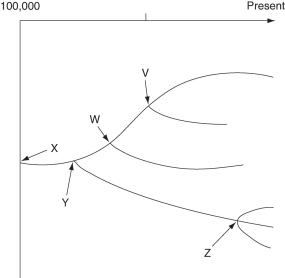The following questions refer to the evolutionary tree in Figure 22.2.
The tree's horizontal axis is a timeline that extends from 100,000 years ago to the present; the vertical axis represents nothing in particular. The labeled branch points on the tree (V-Z) represent various common ancestors. Let's say that only since 50,000 years ago has there been enough variation between the lineages depicted here to separate them into distinct species, and only the tips of the lineages on this tree represent distinct species.

-In a hypothetical environment, fishes called pike-cichlids are visual predators of algae-eating fish (i.e., they locate their prey by sight) . If a population of algae-eaters experiences predation pressure from pike-cichlids, which of the following should least likely be observed in the algae-eater population over the course of many generations?
A) Selection for drab coloration of the algae-eaters
B) Selection for nocturnal algae-eaters (active only at night)
C) Selection for larger female algae-eaters, bearing broods composed of more, and larger, young
D) Selection for algae-eaters that become sexually mature at smaller overall body sizes
E) Selection for algae-eaters that are faster swimmers
Correct Answer:
Verified
Q36: To observe natural selection's effects on a
Q37: The graph in Figure 22.3 depicts four
Q38: The following questions refer to the evolutionary
Q39: Of the following anatomical structures, which is
Q42: Structures as different as human arms, bat
Q43: Which of the following pairs of structures
Q44: The theory of evolution is most accurately
Q45: Logically, which of these should cast the
Q50: The following questions refer to the evolutionary
Q53: The upper forelimbs of humans and bats
Unlock this Answer For Free Now!
View this answer and more for free by performing one of the following actions

Scan the QR code to install the App and get 2 free unlocks

Unlock quizzes for free by uploading documents